Practicing the CBSE Sample Papers for Class 12 Applied Mathematics Set 2 allows you to get rid of exam fear and be confident to appear for the exam.
CBSE Sample Papers for Class 12 Applied Mathematics Set 2 with Solutions
Time Allowed: 3 hours
Maximum Marks: 80
General Instructions:
- This question paper contains five sections A, B, C, D and E. Each section is compulsory.
- Section – A carries 20 marks weightage, Section – B carries 10 marks weightage, Section – C carries 18 marks weightage, Section – D carries 20 marks weightage and Section – E carries 3 case-based with total weightage of 12 marks.
- Section -A: It comprises of 20 MCQs of 1 mark each.
- Section – B: It comprises of 5 VSA type questions of 2 marks each.
- Section – C: It comprises of 6 SA type of questions of 3 marks each.
- Section – D: It comprises of 4 LA type of questions of 5 marks each.
- Section – E: It has 3 case studies. Each case study comprises of 3 case-based questions, where 2 VSA type questions are of 1 mark each and 1 SA type question is of 2 marks. Internal choice is provided in 2 marks question in each case-study.
- Internal choice is provided in 2 questions in Section – B, 2 questions in Section – C, 2 questions in Section – D. You have to attempt only one of the alternatives in all such questions.
Section – A
All questions are compulsory. No internal choice is provided in this section
Question 1.
Modulo arithmetic is the arithmetic of remainders. If a and b are two integer and r is the remainder, then above statement can be represented Mathematically as: [1]
(A) a mod b = r
(B) a mod r = b
(C) r mod a = b
(D) Noneofthese
Answer:
(A) a mod b = r
Explanation: When we divide integer a by b, we have
a = bq + r, whereq, r ∈ land 0 ≤ |b|,
a = dividend, b = divisor, q = quotient, r = remainder
In arithmetic modulo, this statement can be represented as:
a mod b = r
Question 2.
Evaluate: (9 + 23) mod 12 = ………….. [1]
(A) 2
(B) 8
(C) 32
(D) 12
Answer:
(B) 8
Explanation: (9 + 23) mod 12
or, 32 and 12
On dividing 32 by 12, we get remainder = 8
Hence, (9 + 23) mod 12 = 8
![]()
Question 3.
Evaluate: (9 x 8) mod 6 = ………….. [1]
(A) 2
(B) 1
(C) 0
(D) 6
Answer:
(C) 0
Explanation: (9 x 8) mod 6
or 72 mod 6
On dividing 72 by 6, we get remainder = 0
Hence, (9 x 8) mod 6 = 0
Question 4.
Solve for x: 7 x = 3 (mod 5) [1]
(A) 3
(B) 4
(C) 5
(D) 7
Answer:
(B) 4
Explanation: Here, gcd (7, 5) = 1
So, there is exactly one solution which belongs to the
set {0, 1, 2, 3, 4}
7 x 0 ≡ 0(mod5)
7 x 1 ≡ 2(mod5)
7 x 2 ≡ 4(mod5)
7 x 3 ≡ 1(mod5)
7 x 4 ≡ 3(mod5)
Question 5.
If A and B are invertible matrices, then which of the following is not correct? [1]
(A) adj. A = |A| . A-1
(B) det (A-1) = [det (A)]-1
(C) (AB)-1 = B-1A-1
(D) (A + B)-1 = B-1 + A-1
Answer:
(D) (A + B)-1 = B-1 + A-1
Explanation: Since, A and B are invertible matrices,
so, we can say that
(AB)-1 = B-1A-1 …………(i)
Also,
A-1 = \(\frac { 1 }{ |A| }\) (adj A)
adj A = A-1. |A| ……….(ii)
Also, det(A)-1 = [det(A)]-1
det (A)-1 = \(\frac { 1 }{ [det(A)] }\)
det (A)-1 . det(A)-1 = 1 ……………(iii)
From equation (iii), we conclude that it is true.
Again, (A + B)-1 = \(\frac { 1 }{ |(A+B)| }\) adj (A+B)
(A + B)-1 ≠ B-1 + A-1 …………..(iv)
![]()
Question 6.
There are two values of a which makes determinant,

Then sum of these numbers is: [1]
(A) 4
(B) 5
(C) – 4
(D) 9
Answer:
(C) – 4
Explanation:
We have,

Expanding along first column
⇒ I(2a2 + 4) + 2(4a + 0) + 5(8 – 0) = 86
⇒ 2n2 + 4 + 8 a + 40 = 86
⇒ 2a2 + 8a + 44 – 86 = 0
⇒ a2 + 4a – 21 = 0
⇒ a2 + 7a – 3a – 21 = 0
⇒ (a + 7)(a – 3) = 0
Required sum = – 7 + 3 = – 4
Question 7.

and Aij is cofactor of aij. then value of t is given by [1]
(A) a11A31 + a12A32 + a13A33
(B) a11A11 + a12A21 + a13A31
(C) a21A11 + a22 A12 + a233A13
(D) a11A11 + a21A21 + a31A31
Answer:
(D) a11A11 + a21A21 + a31A31
Explanation: We know that:
∆ = Sum of the product of the elements of a column
(or a row) with their corresponding co-factors
∴ ∆ = a11A11 + a21A21 + a31A31
Question 8.
Cramer’s rule fails for ……………. [1]
(A) Determinant > 0
(B) Determinant < 0
(C) Determinant = 0
(D) Determinant = non-real
Answer:
(C) Determinant = 0
Explanation: Cramer’s rule is applicable only when the determinant value is not equal to zero.
![]()
Question 9.
The order and degree (if defined) of the differential equation is: [1]
\(\frac{d^2 y}{d x^2}\) + x(\(\frac { dy }{ dx }\))2 = 2x2 log (\(\frac{d^2 y}{d x^2}\))
(A) 2, 1
(B) 2, 2
(C) 1, 2
(D) 2, not defined
Answer:
(D) 2, not defined
Given differential equation is
\(\frac{d^2 y}{d x^2}\) + x (\(\frac { dy }{ dx }\))2 = 2x2 log (\(\frac{d^2 y}{d x^2}\))
The highest order derivative present in the differential equation is \(\frac{d^2 y}{d x^2}\). So it is of order 2.
Clearly, the differential equation is not expressible as polynomial in \(\frac{d^2 y}{d x^2}\). So, its degree is not defined.
Hence, Order = 2
Degree is not defined.
Question 10.
The least value of such that the function f(x) = x2 + ax + 1 is increasing on (1,2) is: [1]
(A) 0
(B) – 1
(C) – 2
(D) – 4
Answer:
(C) – 2
Explanation: We have, f(x) = x2 + ax + 1
f'(x) = 2x + a
Now, function f will be increasing in (1, 2),
if f’(x) > 0 in (1,2)
f (x) > 0
⇒ 2x + a > 0
⇒ 2x > – a
⇒ x > \(\frac { -a }{ 2 }\)
Therefore, we have to find the least value of a such that
⇒ x > \(\frac { -a }{ 2 }\), where x ∈ (1, 2)
⇒ x > \(\frac { -a }{ 2 }\), where 1 < x < 2
Thus, the least value of a forf to be increasing on (1, 2) is given by,
\(\frac { -a }{ 2 }\) = 1
⇒ a = – 2
Hence, the required value of a is – 2.
Question 11.
The demand function of a commodity is given by: [1]
x = 82 – p
and its total cost function is given by:
T.C. = 1oo + 60x
For maximum profit, the value of x is:
(A) 15 units
(B) 14 units
(C) 13 units
(D) 11 units
Answer:
(D) 11 units
Explanation: Here, demand function.
p(x) = 82 – x
and cost function c(x) = 1oo + 60x
∴ Profit function, P(x) = xp(x) – c(x)
P(x) = x(82 – x) – (100 + 60x)
P(x) = 82x – x2 – 100 – 60x
P(x) = – x2 + 22x – 100
Now, put P’(x) = 0 P’(x) = – 2x + 22
– 2x + 22 = 0
x = 11 P”(x) = – 2
Also, P”(x) = – 2 < 0 (Hence, maximum)
Thus, value of x is 11 units.
![]()
Question 12.
During a pandemic, 10% of the patients who have the disease get complications. If 100 patients of a locality get infected by the disease, then the standard deviation of the number of patient getting complications is: …………….. [1]
(A) 10
(B) 9
(C) 6
(D) 3
Answer:
(D) 3
Explanation:
n = 1oo,
p = \(\frac { 1 }{ 10 }\)
q = \(\frac { 9 }{ 10 }\)
σ = \(\sqrt{npq}\)
= \(\sqrt{100 \times \frac{1}{10} \times \frac{9}{10}}\)
= 3
Question 13.
The normal distribution curve is symmetrical about: [1]
(A) X = μ
(B) X = σ
(C) X = \(\frac { μ }{ σ }\)
(D) X = \(\frac { σ }{ μ }\)
Answer:
(A) X = μ
Explanation: Normal distribution is symmetrical about mean.
Question 14.
Skewness of Normal distribution is ………….. [1]
(A) Negative
(B) Positive
(C) 0
(D) Undefined
Answer:
(C) 0
Explanation: Since the normal curve is symmetric about its mean, its skewness is zero.
Question 15.
The most commonly use mathematical method for measuring the trend is: [1]
(A) Moving average method
(B) Semi average method
(C) Method of least squares
(D) None of these
Answer:
(C) Method of least squares
Question 16.
Which of the following is not the value of depreciation asset at the end of useful life? [1]
(A) Scrap value
(B) Salvage value
(C) Depreciate value
(D) Useful value
Answer:
(D) Useful value
Explanation: Salvage value is sometimes referred to as disposal value, residual value, terminal value, or scrap value. The estimated salvage value is deducted from the cost of the assets in order to determine the total amount of depreciation expenses that will be, reported during the assets useful life.
![]()
Question 17.
A fund which is created to accumulate the money over the years to discharge a future obligation is called: [1]
(A) Perpetuity
(B) Sinking fund
(C) Bond
(D) None of these
Answer:
(B) Sinking fund
Explanation: Sinking is a fund created to discharge a known future liability. The fund is created by investing a certain sum annually at compound interest for a certain period.
Question 18.
If each EMI is used to pay interest and the part of the principal, then loan is said to be [1]
(A) Paid off
(B) Discounted
(C) Amortized
(D) Well settled
Answer:
(C) Amortized
Explanation: An amortized loan is a type of loan that requires the borrower to make scheduled, periodic payments that are applied to both the principal and interest.
DIRECTION: For questions 19 and 20, two statements are given – one labelled Assertion(A) and the other labelled
Reason (R). Select the correct answer to these questions from the codes (A), (B), (C) and (D) as given below:
(A) Both assertioñ (A) and reason (R) are true and reason (R) is the correct explanation of assertion (A).
(B) Both assertion (A) and reason (R) are true and reason (R) is not the correct explanation of assertion (A).
(C) Assertion (A) is true hut reason (R) is false.
(D) Assertion (A) is false but reason (R) is true.
Question 19.
Assertion (A): The solution of differential equation \(\frac { dy }{ dx }\) = 1 – xy + y – x is
log (1 + y) = x – \(\frac{x^2}{2}\) + c.
Reason (R): To solve the given differential equation, we apply variable separation method. [1]
Answer:
Option (A) is correct.
Explanation:
Given, \(\frac { dy }{ dx }\) = 1 – xy + y – x
= 1 + y – x(1 + y)
\(\frac { dy }{ dx }\) = (1 + y)(1 – x)
\(\frac { dy }{ 1+y }\) = (1 – x) dx
Integrating both sides we get
∫\(\frac { dy }{ 1+y }\) = ∫(1 – x)dx
log (1+y) = x – \(\frac{x^2}{2}\) + c
Question 20.
Assertion (A): The present value of a perpetuity of ₹ 3,120 payable at the beginning of each year, if money is worth 6% effective is ₹ 55,000.
Reason (R): The present value of a perpetuity of ₹ 3,120 payable at the beginning of each year, if money is worth 6% effective is ₹ 55,120. [1]
Answer:
Option (D) is corred
Explanation: Given, R = ₹ 3,120 and i = \(\frac { 6 }{ 100 }\) = 0.06
Present value, P = R + \(\frac { R }{ i }\)
= ₹ (13,120 + \(\frac { 3120 }{ 0.06 }\))
= ₹ (3120 + 52,000)
= ₹ 55,120
Section – B
All questions are compulsory. In case of internal choice, attempt any one question only
Question 21.
 [2]
[2]
Answer:
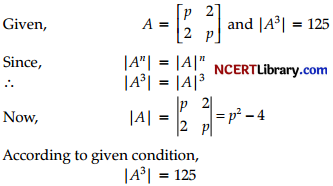
|A|3 = 125
(p2 – 4)3 = 125
(p2 – 4)3 = 53
p2 – 4 = 5
p2 = 9
p = ± 3
Hence, values of p = ± 3
OR
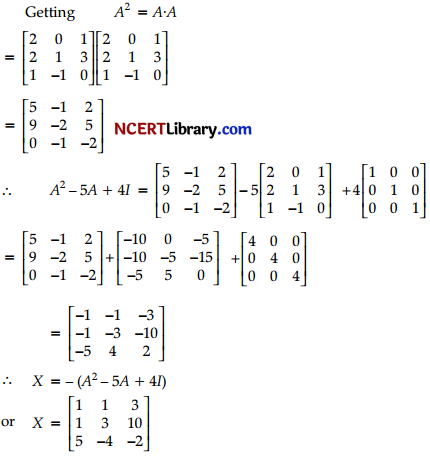
![]()
Question 22.
Find the area of the region bounded above by y = x2 + 1, bounded below by y = x, and bounded on the sides by
x = 0 and x = 1. [2]
OR
If the demand function for a commodity is
p = 35 – 2x – x2.
Then find the consumer’s surplus at equilibrium price P0 = 20.
Answer:
The upper boundary curve is y = x2 + 1 and the
lower boundary curve is y = x.
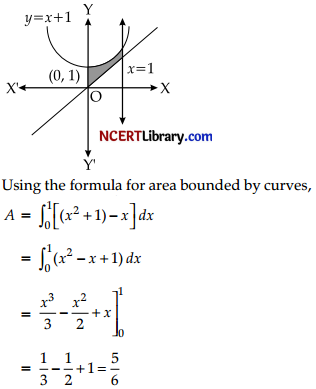
OR
Given, the demand function is
p = 35 – 2x – x2
and the equilibrium price, P0 = 20
Note: At equilibrium demand function is
P0 = 35 – 2x0 – x2
Substituting this value of P0 in (i), we get
20 = 35 – 2x0 – x2
= x02 + 2x0 – 15 = 0
(x0 + 5)(x0 – 3) = 0
x0 = – 5, or x0 = 3
x0≠ – 5, so x0 = 3
So, consumer’s Surplus
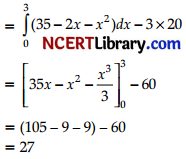
Question 23.
If P(X = 2) = 9P(X = 4) + 90 P(X = 6) in Poisson distribution, then find E(X). [2]
Answer:
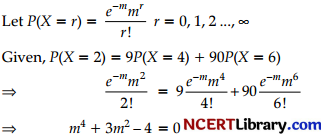
(m4 + 4)(m2 – 1) = 0
m = 1
(∵ other values are not admissible)
Thus, E(X) = m = 1
Question 24.
(a) What is statistic?
(b) Find the sample size for the given standard deviation 10 and the standard error with respect of sample mean is 3. [2]
Answer:
(a) A statistic is used to estimate the value of a population parameter. For instance, we selected a random sample of 100 students from a school with 100 students. The average height of the sampled students would be an example of a statistic.
(b) Given s = 10, S.E. (\(\bar{x}[/latex) = 3
Since, S.E = [latex]\frac{\sigma}{\sqrt{n}}\)
Therefore, 3 = \(\frac{10}{\sqrt{n}}\)
\(\sqrt{n}\) = \(\frac { 10 }{ 3 }\)
Taking square on both sides we get
n = (\(\frac { 10 }{ 3 }\))2
= \(\frac { 100 }{ 9 }\)
= 11.11
≅ 11,
The required sample size is 11.
Question 25.
What are the applications of time series analysis in real field?
Mention the components of the time series.
Answer:
Time series analysis is used for many applications such as: Economic Forecasting, sales forecasting, Budgetary Analysis etc.
There are four types of components in a time series.
- Secular Trend
- Seasonal variations
- Cydic variations
- Irregular variations
Section – C
All questions are compulsory. In case of internal choice, attempt any one question only
Question 26.
Find the remainder when the difference between 60002 and 601 is divided by 6. [3]
OR
Mayank has 44 boxes of soda in his truck. The cans of soda in each box are packed oddly so that there are 113 cans of soda in each box. Mayank plans to pack the sodas into cases of 12 cans to sell. After making as many complete cases as possible, how many sodas will Mayank have leftover? [3]
Answer:
We have 60002 = 10000.6 + 2 and 601 = 100.6 + 1.
So, 60002 ≡ 2(mod 6)
601 ≡ 1(mod 6)
Thus, 60002 – 601 ≡ 2 – 1 ≡ 1(mod 6)
so, 1 is the remainder when the difference is divided by 6.
OR
Here, we have to find the remainder of product 44.113 when divided by 12.
So, 44 = 3.12 + 8
113 = 9.12 + 5
Therefore, 44.113 = (3.12 + 8) (9.12 + 5)
= (3.9).122 + (3.5 + 8.9).12 + (8.5)
Here each part of the product is a multiple of 12, except the product of the remainders when each 44 and 113 are divided by 12. That part of the product is 8.5 = 40, which leaves a remainder of 4 when divided by 12.
So, Mayank has 4 sodas leftover after making as many cases of 12 as possible.
![]()
Question 27.
Ten individuals are chosen at random from the population and their heights are found to be in inches 63, 63, 64, 65, 66, 69, 69, 70, 70, 71. Discuss the freedom value of Student’s – t and 5% level of significance is 2.262. [3]
Answer:
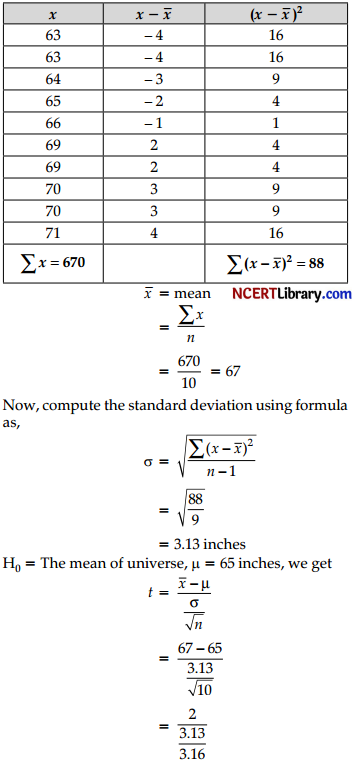
= 2.019
Calculated < tabulated to |t|
So the null hypothesis may be accepted at 5% level of significance.
Question 28.
Fit the straight line trend to the following time series data: [3]
| Year | 2017 | 2018 | 2019 | 2020 | 2021 |
| Sale of sugar (in thousand kg) | 80 | 90 | 92 | 83 | 94 |
Answer
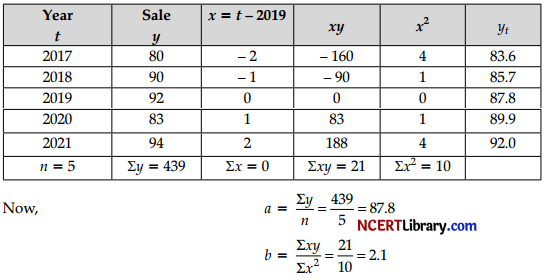
Hence, trend equation is yt = 87.8 + 2.1 x
Question 29.
Solve the following linear programmIng problem graphically: [3]
Minimize: Z = 3x + 9y
When: x + 3, ≤ 6O
X + y ≤ 10
x ≤ y
x ≥ 0, y ≥ 0
OR
(a) A toy company manufactures two types of toys A and B. Demand for toy B is at most half of that if type A.
Write the corresponding constraint if x toys of type A and y toys of type B are manufactured.
(b) Draw the feasible region for given inequation system y ≤ 6, x + y ≤ 3, x ≥ 0, y ≥ 0.
Answer
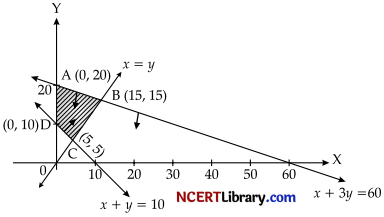
Vertices of feasible region are
A(0, 20), B(15, 15), C(5, 5), D(0, 10)
| Corner points | Value of Z = 3x + 9y |
| (o, 20)
(15, 15) (5, 5) (0, 10) |
180
180 60 → minimum 90 |
Z = 60 is minimum at x = 5, y = 5
OR
(a) Since, the demand of toys of type B is atmost half of that for toys of type A
∴ y ≤ \(\frac { x }{ 2 }\)
⇒ 2y – x ≤ 0
⇒ x – 2y ≥ 0
(b)
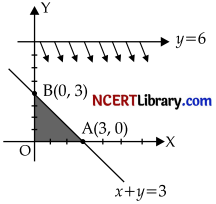
Thus, feasible region is OAB.
![]()
Question 30.
In 10 years, a machine costing ₹ 50,000 will have a salvage value of ₹ 5,000. A New Machine at that time is expected to sell for ₹ 55,000. In order to provide funds for the difference between the replacement cost and the salvage cost, a sinking fund is set up into which equal payments are placed at the end of each year. If the fund earns interest at the rate 6% compounded annually, how much should each payment be ? Given [(106)10 = 1.7908]. [3]
Answer:
Amount needed after 10 years
= Replacement Cost – Salvage Cost
= 55,000 – 5,000 = ₹ 50,000
The payments into sinking fund consisting of 10 an – nual payments at the rate 6% per year is given by
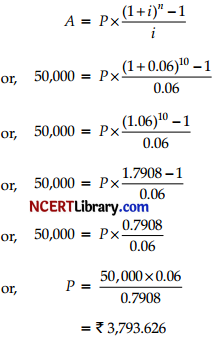
Question 31.
Ram took a home loan of ₹ 50 lakhs at an 8.50 % interest for a 20 years loan tenure. What would be his EMI ? Given
(1.0o70)° = 5.3342 [3]
Answer:
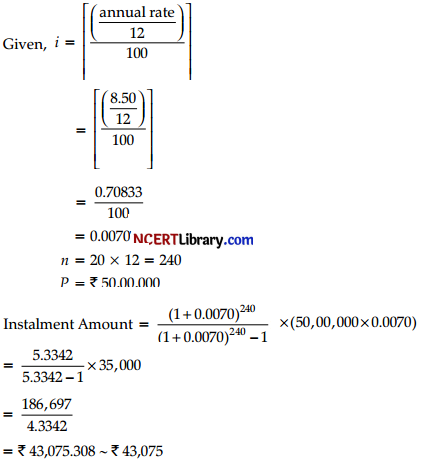
Section – D
All questions are compulsory. In case of internal choice, attempt any one question only
Question 32.
The sum of surface areas of a sphere and a cuboid with sides \(\frac { x }{ 3 }\), x and 2x is constant. Show that the sum of their – volumes is minimum if x is equal to the three times the radius of sphere. [5]
OR
AB is a diameter of a circle and C is any point on the circle. Show that the area of ∆ABC is maximum, when it is isosceles.
Answer:
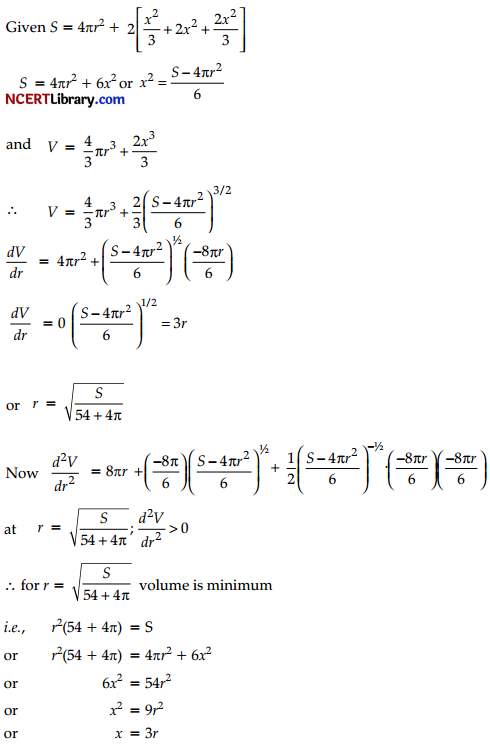
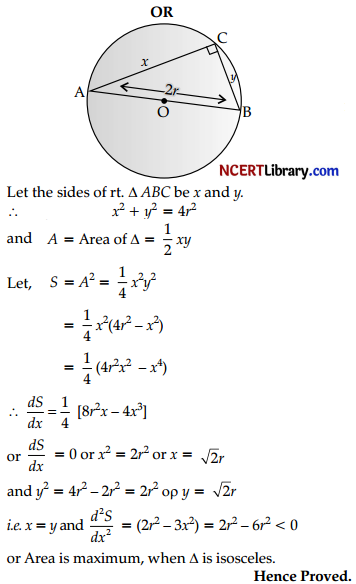
Question 33.
(a) If f(x) is defined by f(x) = ke-2x, 0 ≤ x < ∞ is a density function. Determine the constant k and also find mean.
(b) A class has 15 students whose ages are 14, 17, 15, 14, 21, 17, 19, 20, 16, 18, 20, 17, 16, 19 and 20 years. One student is selected in such a manner that each has the same chance of being chosen and the age X of the selected student is recorded. What is the probability of the random variable X ? Find the mean. [5]
OR
An unbiased coin is tossed 4 times. Find the mean and variance of number of heads obtained.
Answer:
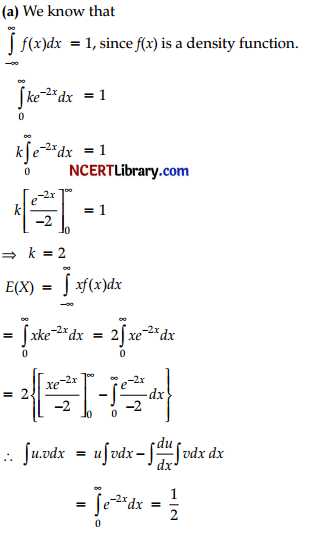
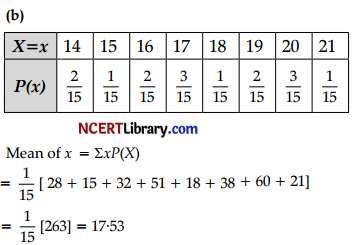
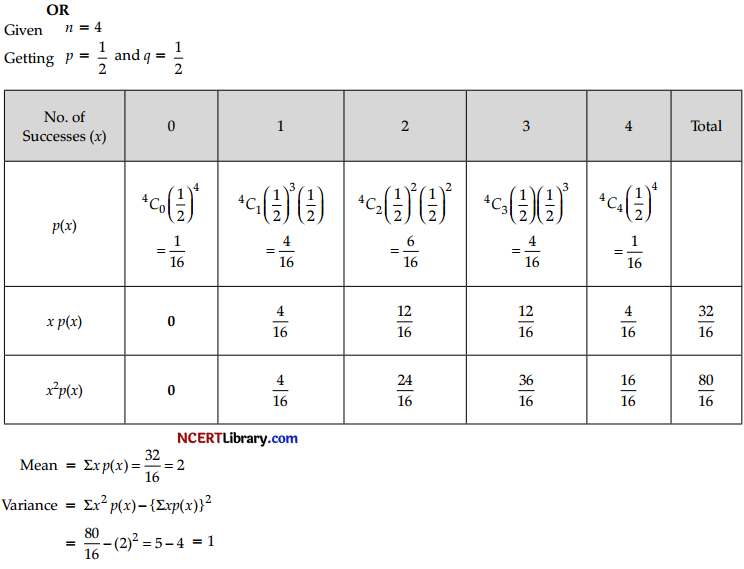
![]()
Question 34.
A company produces soft drinks that have a contract which requires that a minimum of 80 units of chemical A and 60 units of the chemical B go into each bottle of the drink. The chemicals are available in prepared mix packets from two different suppliers. Supplier S had a packet of mix of 4 units of A and 2 units of B that costs ₹ 10. The supplier T has a packet of mix of I unit of A and 1 unit of B that costs ₹ 4. How many packets of mixes from S and T should the company purchase to honour the contract requirement and yet maintain the minimum cost ? Make a LPP and solve graphically. [5]
Answer:
Let x and y units of packet of mixes are purchased from S and T, respectively. If Z is the total cost, then
Z = 10x + 4y ………….(i)
is objective function which we have to minimize.
Here, constraints are:
4x + y ≥ 80 …………..(ii)
2x + y ≥ 60 ……………….(iii)
Also, x ≥ 0 ……………. (iv)
y ≥ 0
Now,4x + y = 80
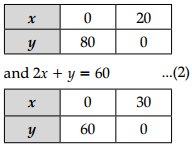
On plotting the graph of above constraints or inequalities (ii), (iii), (iv) and (v), we get shaded
region having corner points A, P, B as feasible region. For coordinate of P
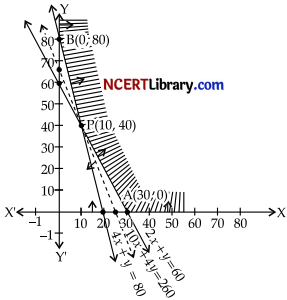
Point of intersection of
2x + y = 60 …………..(vi)
and 4x + y = 80 ………….(vii)
From (vi) – (vii),
2x + y – 4x – y = 60 – 80
– 2x = – 20
x = 10
y = 40
Co-ordinates of P = (10,40)
Now the value of Z is evaluated at corner points in the following table:
| Corner points | Value of Z = 3x + 9y |
| A(3o, 0) | 300 |
| P(10, 40) | 260 → minimum |
| (0, 80) | 320 |
Since, feasible region is unbounded. Therefore, we have to draw the graph of the inequality.
10x + 4y < 260
i.e., 5x + 2y < 130 …….(viii)
Since, the graph of inequality (viii) does not have any point common.
So, the minimum value of Z is 260 at (10, 40).
i.e., minimum cost of each bottle is ₹ 260, if the company purchases 10 packets of mixes from S and 40 packets of mixes from supplier T.
Question 35.
(a) Find the present value of a sequence of payments of ₹ 80 made at the end of each 6 months and continuing forever, if money is worth 5% compounded semi-annually.
(b) On 1st April, 2021, Rekha purchased a LED TV costing ₹ 50,000 and spent ₹ 5,000 on its erection. The estimated effective life of the LED TV is 5 years with a scrap value of ₹ 3000. Calculate the depreciation using linear method with accounting year ending on 31st March 2022.
(c) An investment made by Mr. Roy has initial value ₹ 10,000 and it increases to ₹ 40,000 in 3 years, what will be CAGR? [Given, (4)1/3 = 1.587] [5]
Answer:
(a) Given, R = 80 and i = \(\frac { 0.05 }{ 2 }\)
The present value of a perpetuity,
P = \(\frac { R }{ i }\)
= \(\frac { 80 }{ 0.025 }\)
= ₹ 32,000
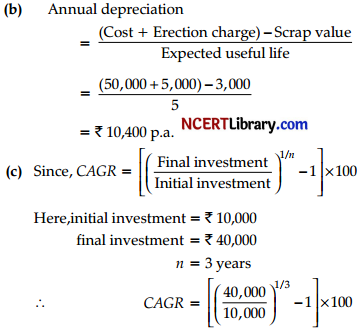
= (41/3 – 1) x 1oo
= (1.587 – 1) x 10o
= 0.587 x 100 = 58.7%
Section – E
All questions are compulsory. In case of internal choice, attempt any one question only
CASE STUDY – I
Question 36.
Mr. Lal was 75 year old businessman. He had two sons and three daughters. On the silver jubilee of his company, he gifted an equal amount of money among his children. One of his daughters buys jewellery from the gifted money whereas the other daughter invested his money in bank. It is known that if the interest is compounded continuously, the principal changes at the rate equal to the product of the rate of bank interest per annum and principal.

Based on the above given information answer the following questions:
(i) If P denotes the principal at time t and the rate of interest be r% per annum compounded continuously, then find the differential equation that models in this scenario is: [1]
(ii) Find the particular solution of the associated differential equation. [2]
OR
At what rate interest rate will loo double itself in lo years ? (loge 2 = 0.6931)
How much will 1000 be worth at 5% interest after 10 years ? (e0.5 = 1.648)
(iii) If the interest is compounded continuously at 5% per annum, in how many years will ₹ 100 double itself ? (loge 2 = 0.6931) [1]
Answer:
(i) If P denotes the principal at time t and the rate of interest be r% per annum compounded continuously, then according to the law given in the problem, we get
\(\frac { dp }{ dt }\) = \(\frac { Pr }{ 100 }\)
(ii) Since, \(\frac { dp }{ dt }\) = \(\frac { Pr }{ 100 }\)
\(\frac { dp }{ dt }\) = \(\frac { r }{ 100 }\) dt
∫\(\frac { dp }{ dt }\) = \(\frac { r }{ 100 }\) ∫dt
log P = \(\frac { rt }{ 100 }\) + C ………..(i)
Let P0 be the initial principal i.e., at t = 0, P = P0.
Putting P = P0 in eq. (1), we get
log P0 = C
Putting C = log P0 in eq. (j), we get
logP = \(\frac { rt }{ 100 }\) + 1ogP0
log (\(\frac{P}{P_0}\)) = \(\frac { rt }{ 100 }\)
OR
We have,
log (\(\frac{P}{P_0}\)) = \(\frac { rt }{ 100 }\)
Put t = 10, P0 = ₹100 and P = ₹ 200 = 2P0 in the
above equation, we get
log 2 = \(\frac { 10r }{ 100 }\)
r = 10 1oge 2
r = 1o x 0.6931
= 6.931% or 6.93 % per annum
(iii) We have,
log (\(\frac{P}{P_0}\)) = \(\frac { rt }{ 100 }\)
Put r = 5%, P0 = ₹ 1000 and f = 10 in the above equation, we get
log (\(\frac { P }{ 1000 }\)) = \(\frac { 5 x 10 }{ 100 }\)
= \(\frac { 1 }{ 2 }\) = 0.5
log (\(\frac{P}{P_0}\)) = \(\frac { rt }{ 100 }\)
Put r = 5, P0 = ₹ 1oo and P = ₹ 200 = 2P0 in the above
equation, we get
log 2 = \(\frac { 5t }{ 100 }\)
t = 20 loge 2
= 20 x 0.6931
= 13.86 years
CASE STUDY-II
![]()
Question 37.
A shopkeeper has 3 varieties of pen ‘A’, ‘B’ and ‘C’. Meenu purchase I pen of each variety for a total of ₹ 21. Jeevan purchase 4 pens of ‘A’ ‘ariety, 3 pens say ‘B’ variety and 2 pens of ‘C’ variety for ₹ 60. While Shikha purchased 6 pens of ‘A’ variety, 2 pens of ‘B’ variety and 3 pens of ‘C’ variety for ₹ 70.

(i) Write the syslern of equations for the given information. [1]
(ii) If the given system of equations can be written as AX = B, then find |A|. [1]
(iii) Find A-1. [2]
OR
Find the cost of pens of varieties A, B and C.
Answer:
(i) Let the cost of ‘A’ variety pen be x, the cost of ‘B’ variety pen be y, the cost of ‘C’ variety pen be z.
According to the question,
x + y + z = 21
4x + 3y + 2z = 60
6x + 2y + 3z = 70
(ii) The given system of the questions can be written as
AX = B, i.e.
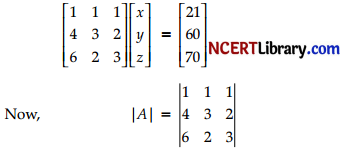
= 1(9 – 4) – 1(12 – 12) + 1(8 – 18)
= 5 – 10 = – 5 ≠ 0
(iii) Since |A| ≠ 0, thus A-1 exists, so the given system of equation has unique solution X = A-1B
A11 = (9 – 4) = 5
A12 = – (12 – 12) = 0
A13 = (8 – 18) = – 10
A21 = – (3 – 2) = – 1
A22 = (3 – 6) = – 3
A23 = – (2 – 6) = 4
A31 = (2 – 3) = – 1
A32 = – (2 – 4) = 2
A33 = 3 – 4 = – 1
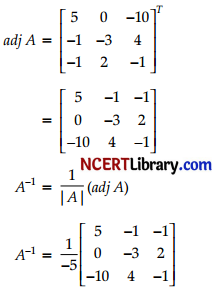
OR
Since,
AX = B
X = A-1 B
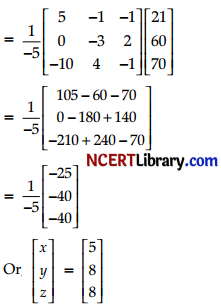
Hence, cost of ‘A’ variety pen is ₹ 5.
cost of ‘B variety pen is ₹ 8.
cost of ‘C’ variety pen is ₹ 8.
CASE STUDY – III
Question 38.
Akshay and Ritesh are the neighbours. They are studying in the same school. Both are taking tuitions from same teacher. One day they have combined tution class in which teacher explain about the topic Alligation and Mixtures. Teacher said, according to alligation rule” if two ingredients at a given price are mixed to produce a mixture at given price, the ratio of quantity of cheaper ingredient and quantity of dearer ingredient is given by
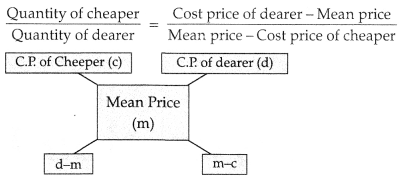
(i) Five litres of water is added to a certain quantity of pure milk costing ₹ 60 per litre. ¡f by selling the mixture at same price as before, a profit of 20% is made, what is the amount of pure milk in the mixture? [1]
OR
Two liquids one mixed in the proportion 3 : 2 and the mixture is sold at ₹110 per litre at 10% profit. If first liquid costs ₹ 20 more per litre than the second, what does it cost per litre? [1]
(ii) A grocer wishes to sell a mixture of two variety of pulses worth ₹ 16 per kg. In what ratio must he mix the pulses to reach this selling price, when cost of one variety of pulses is ₹ 14 per kg and the other is ₹ 24 per kg? [2]
(iii) How much water must be added to 60 litres of milk at 1\(\frac { 1 }{ 2 }\) litres for ₹ 20 so as to have a mixture worth ₹ 10 \(\frac { 2 }{ 3 }\) autre?
Answer:
(i) Let quantity of pure milk be x litres. It is given that the mixture is sold at a profit of 20% and the selling price of the mixture is ₹ 60 per litre.
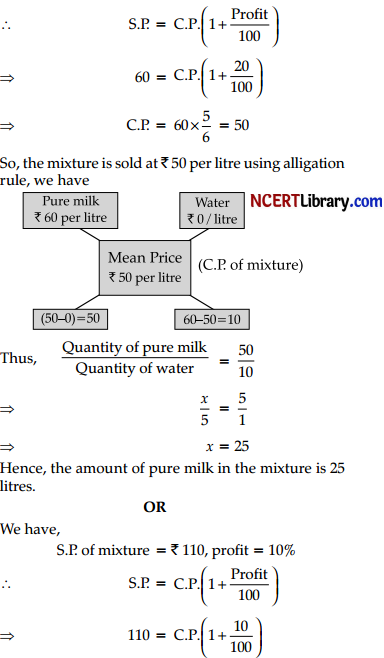
110 = C.P.\(\frac { 110 }{ 100 }\)
C.P = ₹ 100
Let the C.P. of second liquid be ₹ x. then, C.P. of first liquid = ₹ (x + 20)
Thus, we have
C.P of first liquid = ₹ (x + 20)
C.Pofmixture = ₹ 100
The alligation grid is as given below:
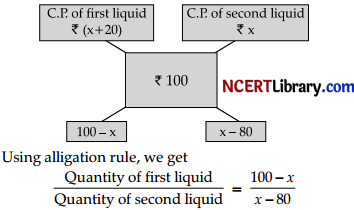
But it is given that two liquids are mixed in the
proportion 3 : 2.
\(\frac { 100 – x }{ x – 80 }\) = \(\frac { 3 }{ 2 }\)
⇒ 200 – 2x = 3x – 240
⇒ 5x = 440
⇒ x = 88
hence, cost price of second liquid is ₹ 88.
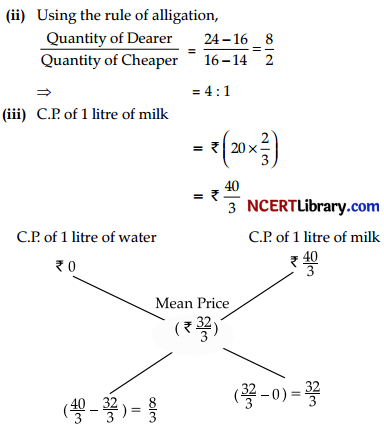
∴ Ratio of water and milk = \(\frac { 8 }{ 3 }\) : \(\frac { 32 }{ 3 }\) = 8 : 32 = 1 : 4
Quantity of water to be added to 60 litres of milk
= (\(\frac { 1 }{ 4 }\) x 60) litres = 15 litres.